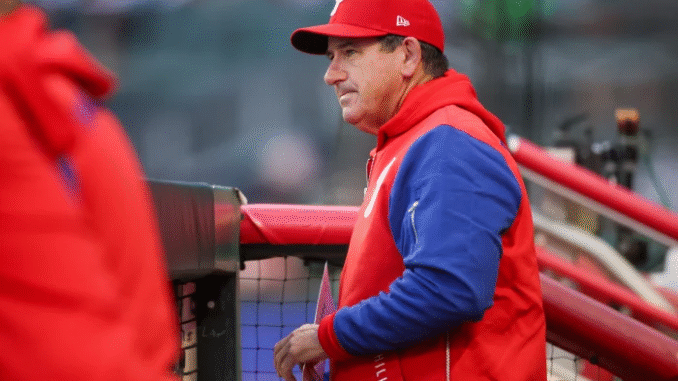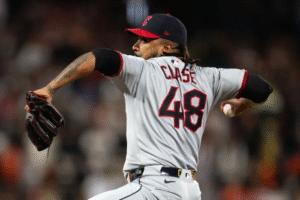
Strengthening the Phillies’ Pen: A Deadline Necessity
With the MLB trade deadline fast approaching, the Philadelphia Phillies find themselves zeroing in on one glaring weakness— their bullpen. A series of events has crystallized the urgency to fortify their relief corps, particularly in the late innings. At the forefront of their concerns is the absence of a steady, high-leverage closer—a role vital for any contender with playoff aspirations.
The Alvarado Blow and Romano’s Roller Coaster
Leading the charge among these bullpen woes is the suspension of left-handed flamethrower José Alvarado. His eight-decade ban has torn a significant hole in their relief depth. In the wake of his departure, Jordan Romano—acquired midseason—was thrust into the flamethrower’s role that Philly desperately needed filled. Yet, inconsistencies have dogged Romano’s performance; at times, he flashes dominance, while others leave fans holding their breath.

The Phillies, historically reliant on late-inning stability to maintain leads, suddenly faced a glaring deficiency. With a key arm sidelined and his presumed replacement underwhelming, the front office has had no choice but to enter the waiver wire and trade conversation early—with urgency
Cleveland’s Emmanuel Clase: A Potential Solution
Within this context, Yahoo Sports MLB insider Russell Dorsey floated an intriguing proposition: targeting Cleveland Guardians’ closer Emmanuel Clase. It’s a bold move, considering Clase’s status as one of the most dominant relievers of recent seasons. Yet the numbers, the reputation, and the present-day need for Philadelphia align to make such a trade a reasonable possibility.
Clase’s Dominance in 2024
Just last year, Clase was arguably the most dominant bullpen presence in baseball. His 2024 campaign was so exceptional that he finished third in AL Cy Young voting—a rare and prestigious acknowledgment for a reliever. Cy Young honor votes typically go to starting pitchers who log hundreds of innings; for a closer to place that high reflects elite, season-long dominance.
2025: A Rocky Start, A Steady Turnaround
This season, however, Clase has experienced turbulence. Once a shut-down force in the postseason, he struggled last October. That difficulty has carried over into 2025. Through a dozen weeks, his stat line — 4 wins, 1 loss, and a 3.82 ERA across 32 outings — contrasts sharply with the sub-1.00 ERAs he once regularly posted. The complexion of his innings, his strikeout-to-walk ratio, and other underlying metrics left observers wondering if he might be slipping.
Yet the script is now reverting to the familiar. Over his most recent 15 appearances, Clase has posted a much more reassuring 1.88 ERA, picking up seven saves. His command has returned, his velocity and movement remain high-end, and he’s closing games once again like an All-Star. In short, he appears to be reasserting the dominance that made him a two-time AL Reliever of the Year.
Contract Structure Makes Him Obtainable
Not only has Clase recaptured his peak form, but his contract situation also makes him a tantalizing trade target. Under team control through 2026, with club options in both 2027 and 2028, he represents a multi-year asset—rare for a dominant reliever. That longevity increases his appeal: a contender not only shores up their current roster but secures late-inning security for multiple seasons without negotiating an expensive free-agent deal.
Cost-Benefit: Pricey But Justified
Bringing in Clase won’t come cheap—trading for elite relievers usually demands a hefty package. But for this Phillies organization—poised for a run, stacked with both young talent and veteran core pieces—the price may be worth it. A reliable closer is almost universally considered a non-negotiable prerequisite for a team expecting to compete for the World Series.
Phillies’ Broader Blueprint
Philadelphia’s core—Trea Turner, Bryce Harper, and their power-packed lineup—already provides an offense capable of producing big innings. Their rotation, likely led by Zach Wheeler or Aaron Nola, has the depth to grind through most lineups. What they’ve lacked is the final three outs—a dependably locked-in stopper against the game’s most dangerous hitters down the stretch.
Postseason Context
The postseason magnifies every bullpen deficiency. One shaky ninth inning, one blown save, and a season of regular-season success can evaporate. History shows that playoff winners routinely boast some of baseball’s best back-end arms, often with dominant 9th-inning specialists leading the way.
How the Trade Could Unfold
Trader’s Dilemma: What to Offer?
To acquire a top-tier closer like Clase, the Phillies would presumably need to offer a compelling return. Cleveland may request a high-upside single asset (e.g., a MLB-ready pitching piece) or a package of several mid- to high-level prospects. Tracking precedents—like Aroldis Chapman to the Yankees, Josh Hader to the Padres, or Edwin Díaz to the Mets—reveals that cost typically involves a mix of upper-echelon minor league talent and MLB pieces.
For Philadelphia, they could afford to shed a veteran outfielder or two, or dip into their fertile farm system to send high-upside arms in return. It’s a balancing act: offering enough to close the deal, but not mortgaging future depth or giving away irreplaceable pieces.
Cleveland’s Motivations
Why would the Guardians consider trading a high-caliber reliever still under contract? A few plausible angles:
1. Budget considerations. While Clase is not yet arbitration-eligible, his options may carry higher salaries, giving Cleveland reason to entertain offers.
2. Bullpen depth. The Guardians may believe they have suitable backend replacements (like Scott Barlow or Eli Morgan) under club control.
3. Contender vs. Rebuild. Kansas City, Toronto and Cleveland each flirt regularly with “sell” mode near July, especially if playoff cohesion seems uncertain.
The Perfect Timing?
According to Dorsey, the Phillies “could not have timed their pursuit better.” Clase’s early 2025 hiccups deflated his trade value, but his resurgence over the last month has provided a more balanced market snapshot. The Guardians see a man who has returned to form, Philadelphia sees the light-returned stopper they so desperately need. Both sides have concrete data and momentum to justify exploration.
What’s at Stake
For the Phillies
Securing ninth-inning dominance. More than just shoring up one role, adding Clase sends a strong message: they believe in their World Series prospects and are unafraid to invest.
Freeing up stability. Jordan Romano can revert to multi-inning setup duty, and the Phillies can deploy their bullpen more flexibly—with reliable late-inning coverage in hand.
Maintaining contender status. For a franchise that missed the playoffs entirely as recently as 2023, this aggressive stance underscores a renewal of ambition.
For the Guardians
Asset maximization. Trading Clase at a moment when his value has rebounded lets Cleveland get a good return, without bailing mid-struggle.
Long-term flexibility. Shed a potential arbitration headache and reinvest in controllable arms or position players.
Midseason strategy. If they’re “on the bubble,” this move could catalyze a full sell-off or pivot toward future seasons.
Trade Deadline Buzz: Realistic or Fantasy?
Baseball insiders and Twitter analysts have begun to chatter about a Phillies–Guardians late-inning reliever swap. Though other contenders such as the Yankees, Mets, Braves, and Dodgers occasionally surface in Clase rumors, Dorsey’s pitch hinges on two central truths:
1. The Phillies’ desperation. With Alvarado gone, Romano inconsistent, and no internal closer emerging, time has run out to rely on internal improvement.
2. Clase’s availability. With recent form restored and multi-year control, he’s a more attractive, less risky acquisition than a rental closer.
Analysts’ Divide
Proponents point to Philly’s immediate need and Cleveland’s flexibility, suggesting it’s more than just rumor—it’s strategy.
Skeptics argue that Cleveland may prefer in-house stabilizers, or hold out for even higher prospect packages or trade partners deeper into the season.
Financially, this wouldn’t be a blockbuster comparable to Yankees–Aroldis Chapman or Mariners–Díaz; rather, a moderately big deal—a few prospects in exchange for multi-year locked-in elite relief.
Final Word: Perfect Opportunity
If the Phillies want to transform their bullpen from liability to luxury, signing an elite closer like Clase is both logical and necessary. At the very least, they owe it to the team and fan base to explore the possibility hard—with the trade deadline less than a week away, time is slipping.
Bottomline
Jose Alvarado’s suspension left Philadelphia dangerously exposed in late innings.
Jordan Romano has displayed flashes but remains unreliable.
Emmanuel Clase fits the mold: dominant, reclaiming form, cost-controlled, and attainable.
Trade value exists for both: Cleveland can capitalize, Philly can solidify.
Deadline approach demands boldness—and this would be that kind of movie
Postscript
Looking ahead, the deadline actions taken (or passed on) by the Phillies could define their season. For fans, analysts, and rival GMs alike, the potential move for Clase embodies a pivotal crossroads: does Philly lean into contention with Louder payroll, or double down on internal options? As July turns to August, the answer may well be written in late-game outs.
Leave a Reply